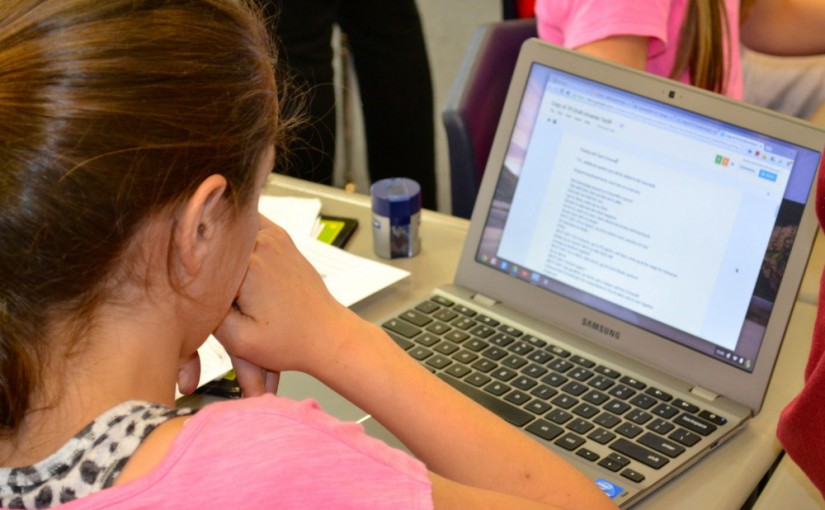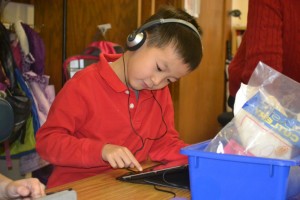
In January, I wrote that a traditional assignment, submitted to the teacher, graded behind the scene and sent home to be recycled, is no longer an effective method for monitoring student achievement. In addition to lacking an authentic audience and not reaching students where they are, they also fall short of any real meaning or in preparing students for their future.
These assignments have an audience of “one” and a recipe of just enough effort to get by. Inside every student are passions that the school experience should ignite and anything that lacks a spark should be avoided.
As an adult, options to collaborate, work on relevant projects and reach an authentic audience are available both personally and professionally. Our passions are limited only by our time and energy. Why then are we not infusing lessons with meaningful opportunities (and more) for our students?
 Outside school, students are connected to multiple social media streams, reading and searching the web, texting with friends, collaborating, debating the best QB in the NFL etc. Yet during school hours, students require permission to collaborate, explore, create and curate. To be fair, using technology outside school is likely for personal reasons, however these skills are required to thrive in a high-paced, technology world and school should tap into this skill set for educational purposes.
Outside school, students are connected to multiple social media streams, reading and searching the web, texting with friends, collaborating, debating the best QB in the NFL etc. Yet during school hours, students require permission to collaborate, explore, create and curate. To be fair, using technology outside school is likely for personal reasons, however these skills are required to thrive in a high-paced, technology world and school should tap into this skill set for educational purposes.
We must empower students and provide a variety of meaningful opportunities, with the bonus of creating exciting lessons that have a real chance to make connections after hours. Students are ready for the next steps. We can either lead the way by using safe, school provided tools to share knowledge and experiences or we can take a “they’ll figure it out on their own” approach.
On this post, I won’t be sharing the recipe for a perfect, passion igniting lesson. (If you are new to EdTech, those are stored under the teacher’s room microwave).  However, when you create, adapt and teach that technology infused home-run of a lesson, there is a simple tool that provides respect for both your effort and your students.
Over the past month, I created a proposal surrounding the idea of a digital portfolio. The full proposal can be found here.
You might be thinking, “How does a digital portfolio relate to the “nuts-and-bolts†of your curriculum and what I do in the classroom?”  Throughout the literacy anchor standards of the Common Core, all students must demonstrate proficiency in standards requiring and bolstered by the use of technology. Below are just a few of the ELA standards that jump out:
- Produce clear and coherent writing in which the development, organization, and style are appropriate to task, purpose, and audience. (CCSS.ELA-LITERACY.CCRA.W.4)
- Conduct short as well as more sustained research projects based on focused questions, demonstrating understanding of the subject under investigation. (CCSS.ELA-LITERACY.CCRA.W.7)
- Integrate and evaluate content presented in diverse media and formats, including visually and quantitatively, as well as in words. (CCSS.ELA-LITERACY.CCRA.R.7)
- Gather relevant information from multiple print and digital sources, assess the credibility and accuracy of each source, and integrate the information while avoiding plagiarism. (CCSS.ELA-LITERACY.CCRA.W.8)
EdTech Consultant Will Kimbley recently tweeted out that there are 88-standards in the Common Core that require the use of technology. Let that sink in.
RT @willkimbley There are 88 standards on #CCSS #ELA standards that require the use of technology as young as kindergarten #bfccps
— Luke Callahan (@CallahanLuke) May 3, 2014
At minimum, traditional assignments must become digitized and updated to engage students at a deeper and personalized level.  What every school needs is a technology department capable of providing a digital portfolio as a showcase for all the effort taking place on the classroom. Without a way to collect, discuss, reflect, share, collaborate, projects will continue to have an audience of “one”, hit the trash can when they get home and lack any real meaning.
A gap is widening between schools that adapt, persevere and grow using available digital tools and those using worn-out measures. Not to be left out, technology departments that lack the personnel to support integration are missing the mark, to the detriment of their students as well.
What is a Digital Portfolio?
A digital portfolio offers each student the ability to create, reflect and be active in their learning. A major goal is to attract an authentic audience for their efforts, empowering students to connect with peers, schools, teachers and with their world. Their digital portfolio should capture academic growth and also ignite a flame that the world is a potential audience, not just their teacher.
What belongs on a digital portfolio can vary and be flexible throughout an academic career. Given an opportunity to be in control of the direction of their portfolio, students will naturally be inspired to share their best work. Research supports that student choice increases student motivation and engagement in their learning.
The creation and selection of artifacts will prepare students to become curators and strong digital citizens, capable of showcasing a discerning eye, providing critique, and showing an understanding of the curriculum.
Also, a byproduct of maintaining a digital portfolio, students create a strong and positive digital footprint. As more colleges and businesses look at an applicant’s online footprint, the digital portfolio is a wonderful collection of growth and talents.
What a Digital Portfolio Isn’t
The digital portfolio should be more than just an online folder, hosting odds and ends. Instead it should strive to reach an authentic audience and receive thoughtful commentary. A digital portfolio isn’t a collection of only “A+†projects, but should capture student creativity and their best work. The idea of reaching a variety of audiences beyond the classroom, is an expectation of the Common Core State Standards and a digital portfolio supports this expectation.
With the integration of the digital portfolio into the classroom, students must approach their online activity with caution and examine consequences of their activities. With consistency and support from teachers, students should be thoughtful of what they post to their digital portfolio and the decision making process is of extreme importance to the 21st century student. Working under the confines of a school issued account and a staff committed to the promotion of a strong digital literacy curriculum, students have opportunities to explore and grow along with sharing their successes in a safe, protected digital environment inside and outside of school.
A digital portfolio is simply a canvas upon which students can showcase their learning and alone is not “the” solution. What the final product is and how it is presented will greatly vary from year to year and from district to district.
The technology leader, teachers and administrators, must share opportunities to promote the exciting, amazing work of their students to the greater community and world.
We must model lifelong learning and connecting with the world. A digital portfolio initiative will showcase growth, provide a level of respect for your efforts and cement your school’s standing as a forward thinking, learning organization.
Student blogging meets 9 out of the 10 Common Core ELA Anchor Standards for Writing…and it eliminates the need for keyboarding classes.
 Will Kimbley, M.S. (@willkimbley) June 12, 2014
